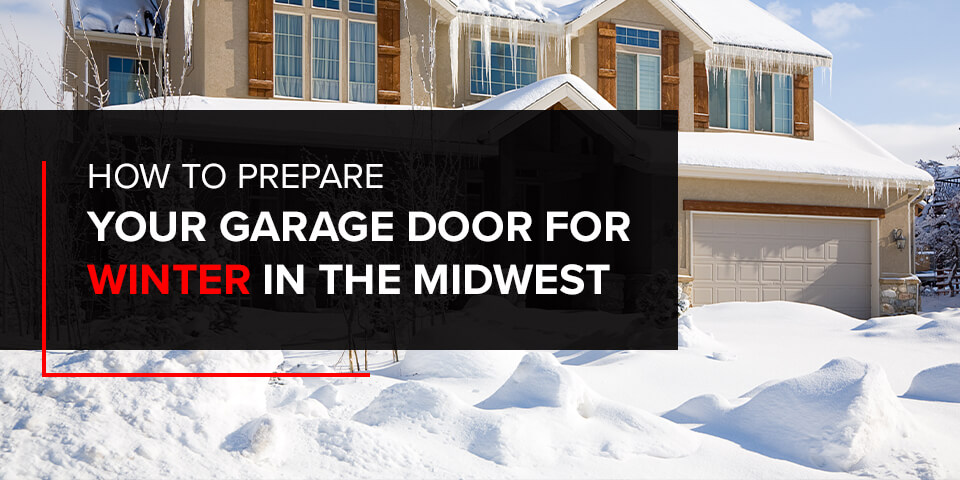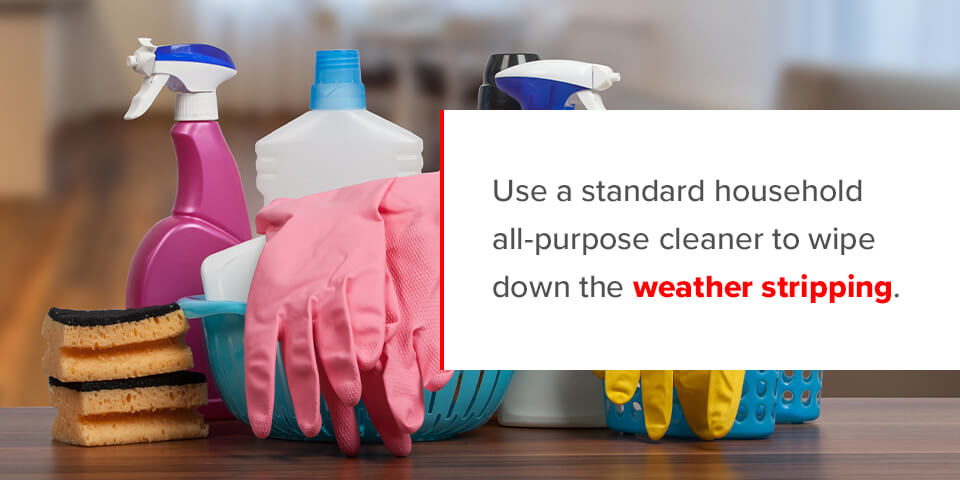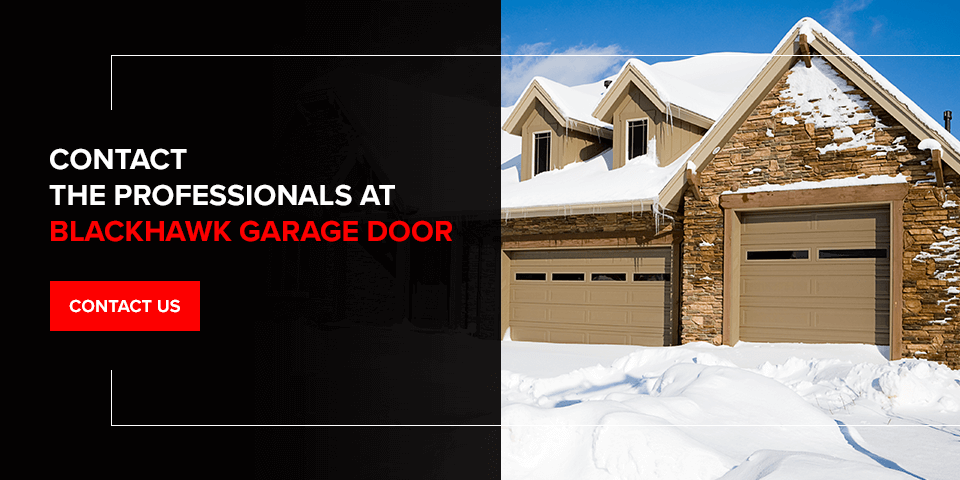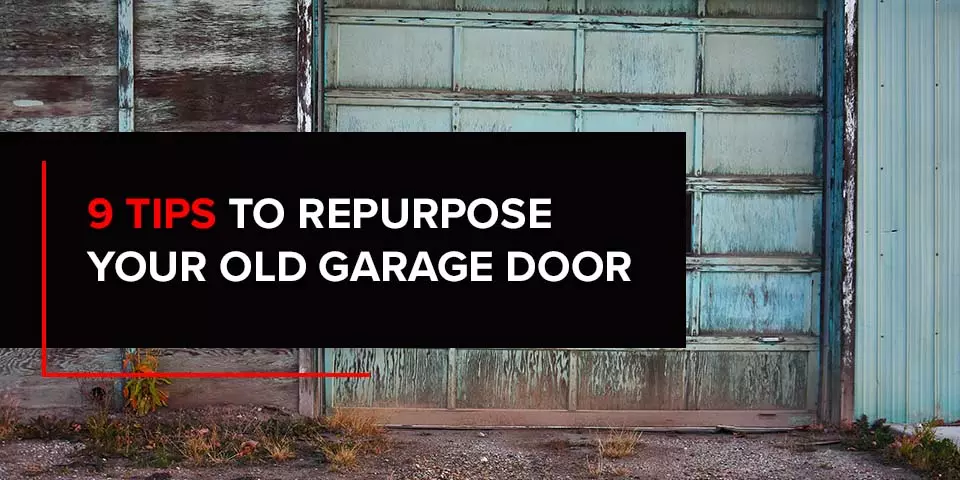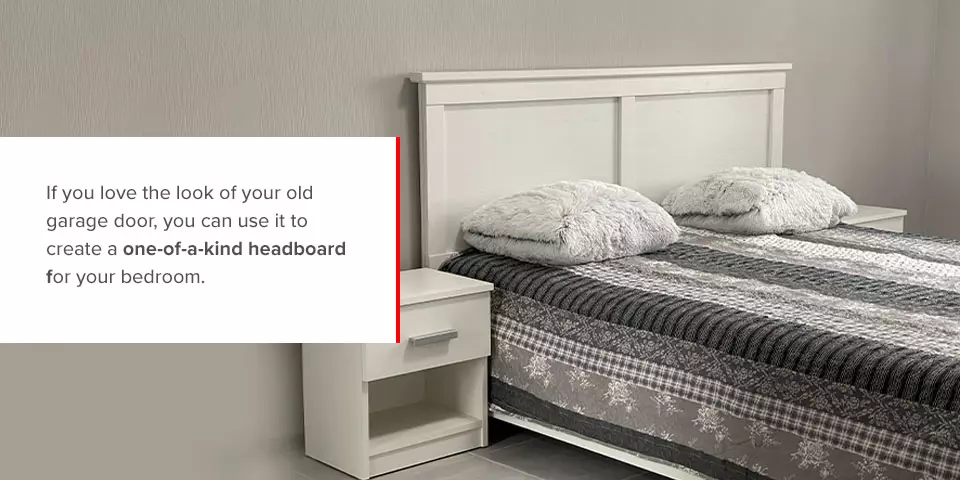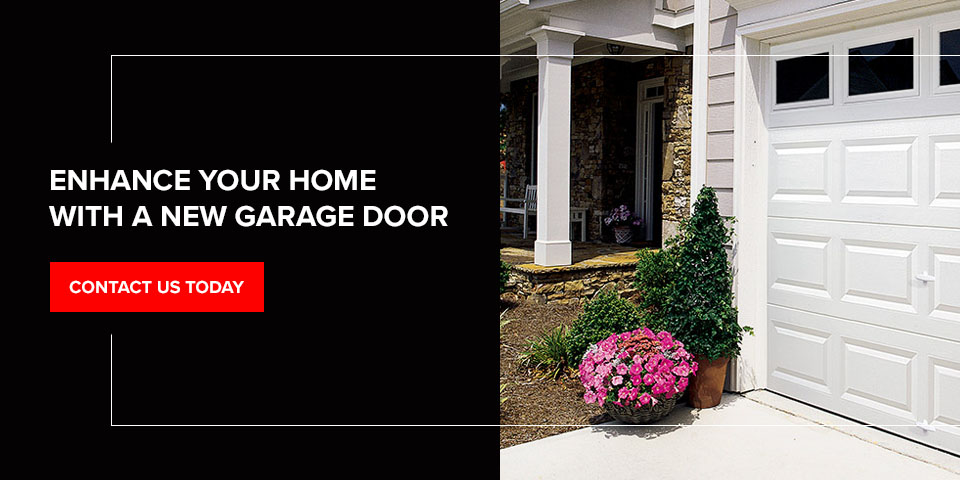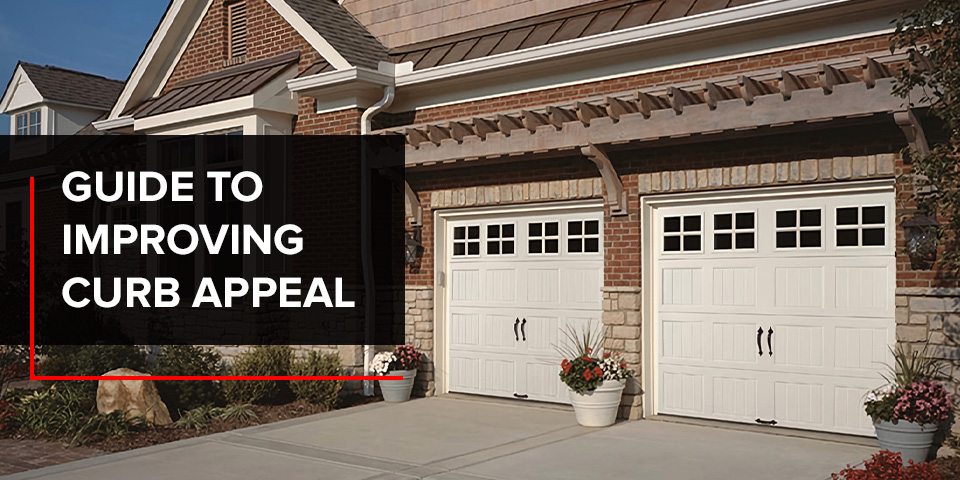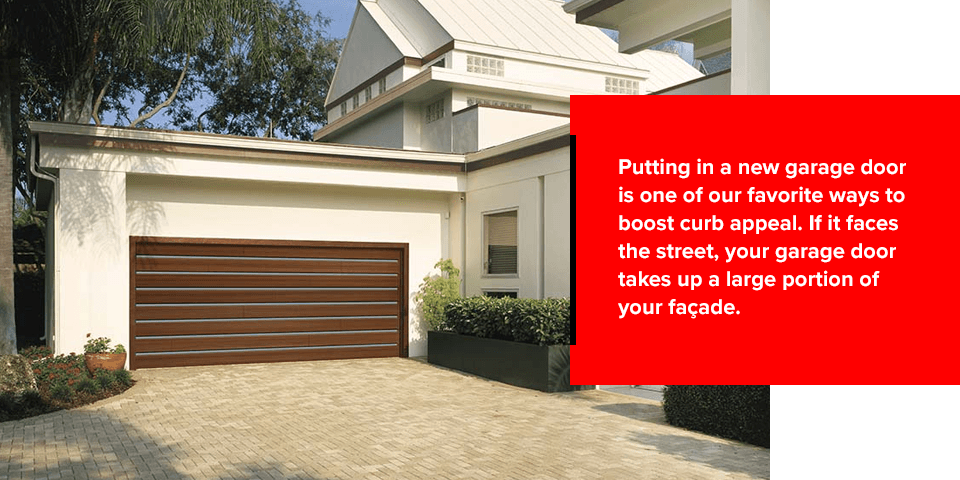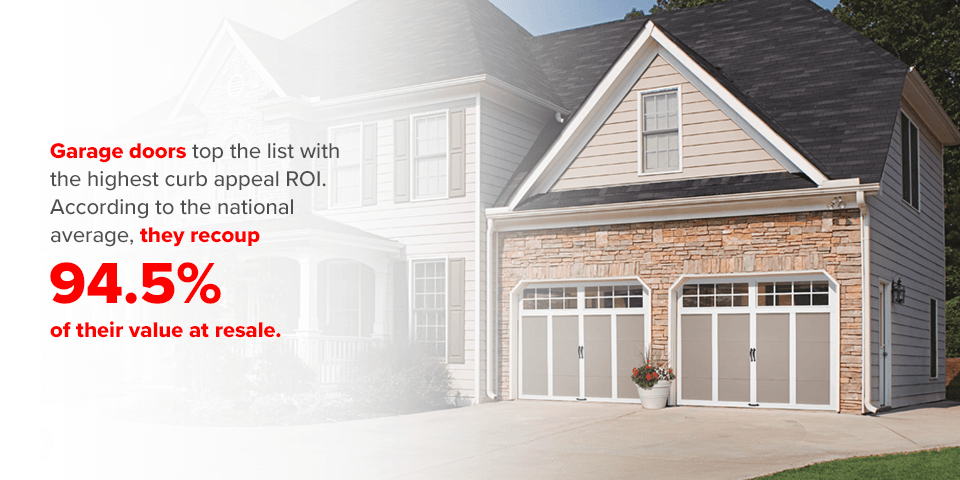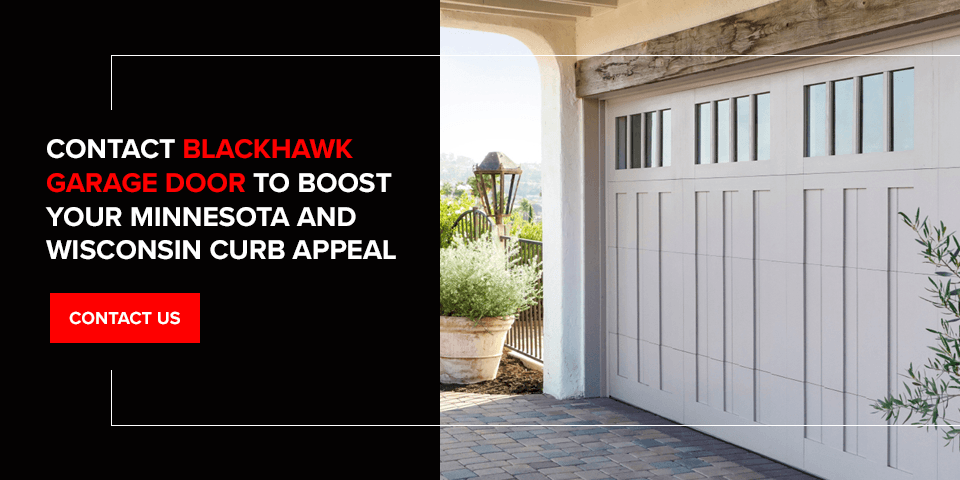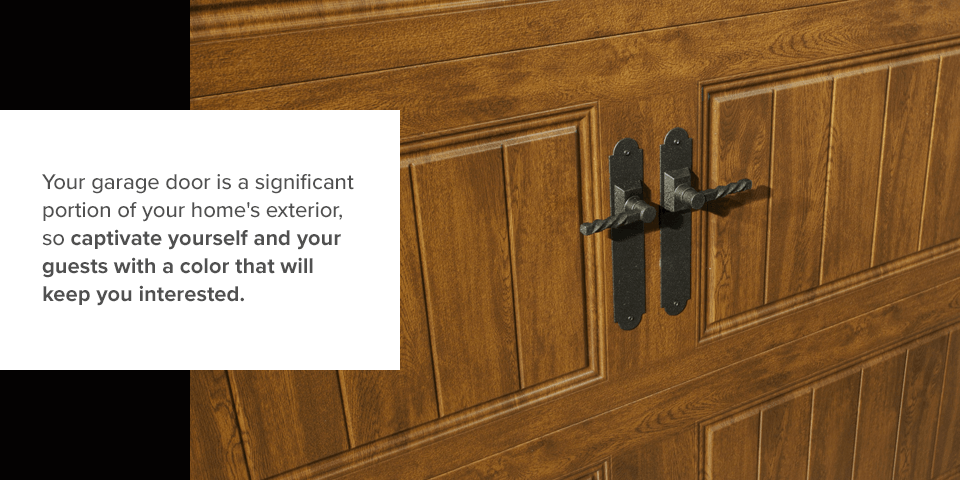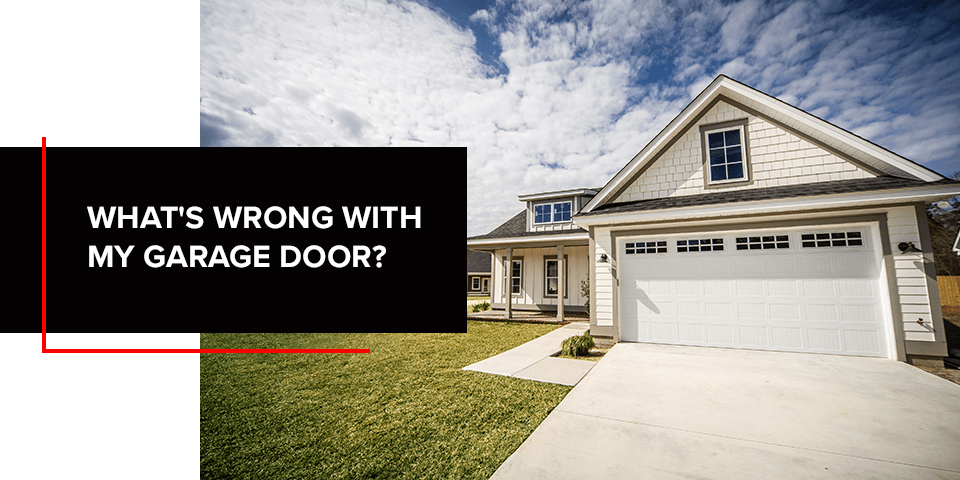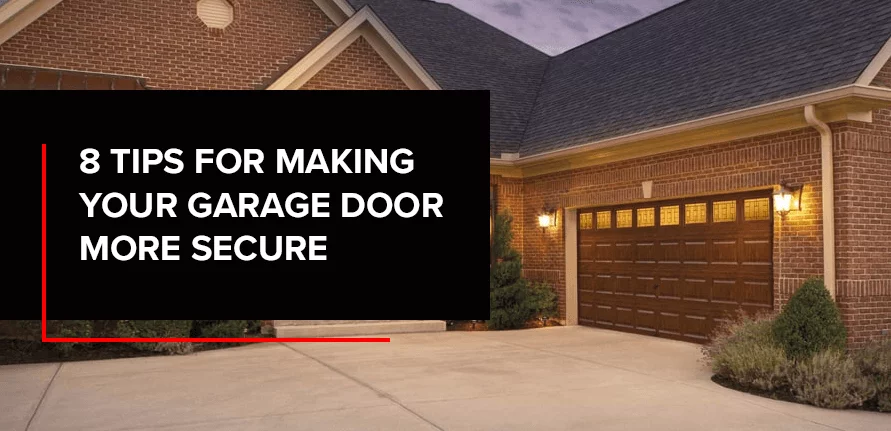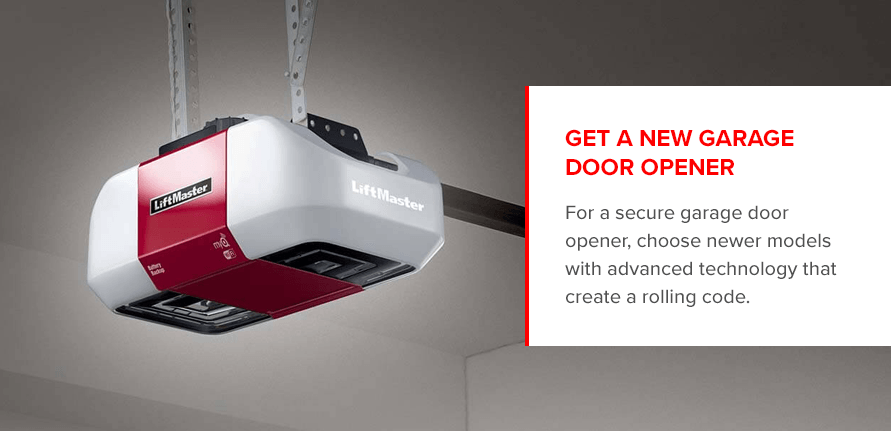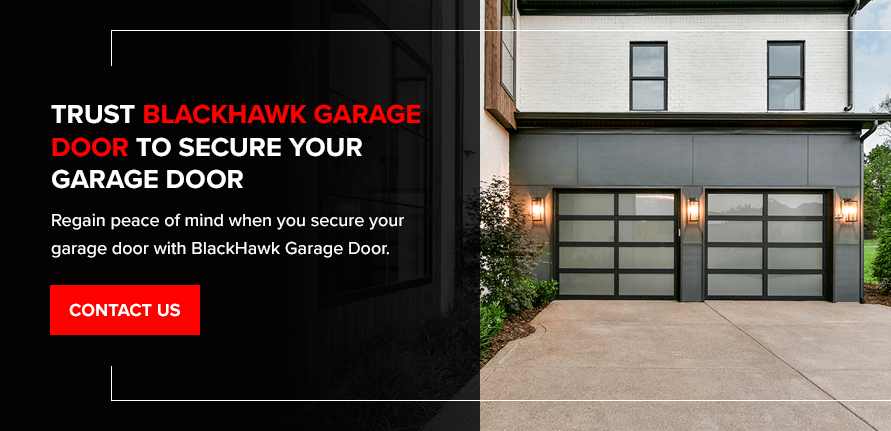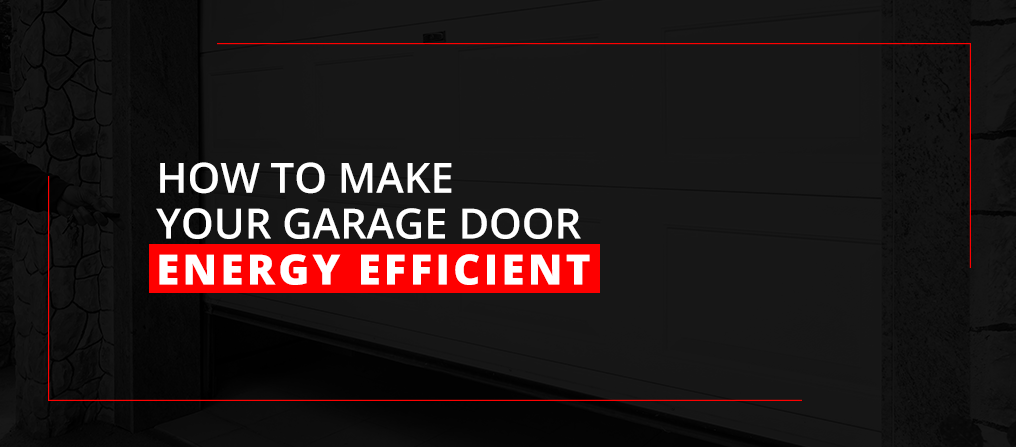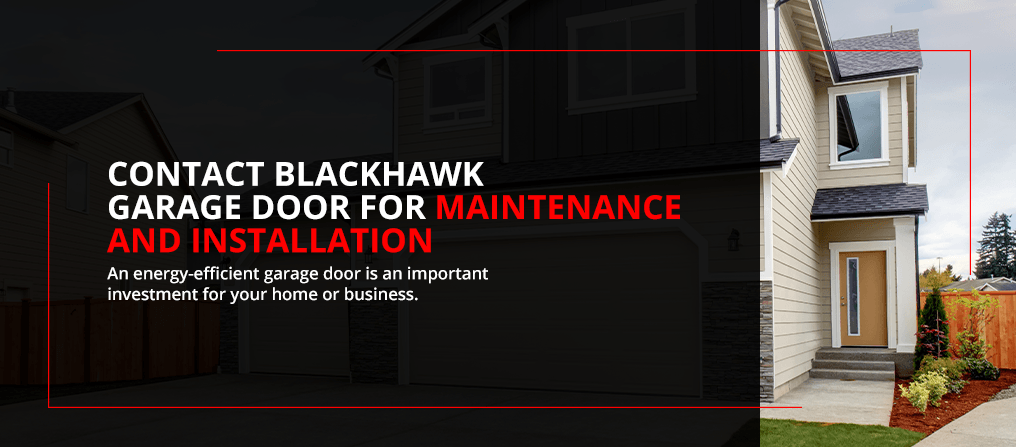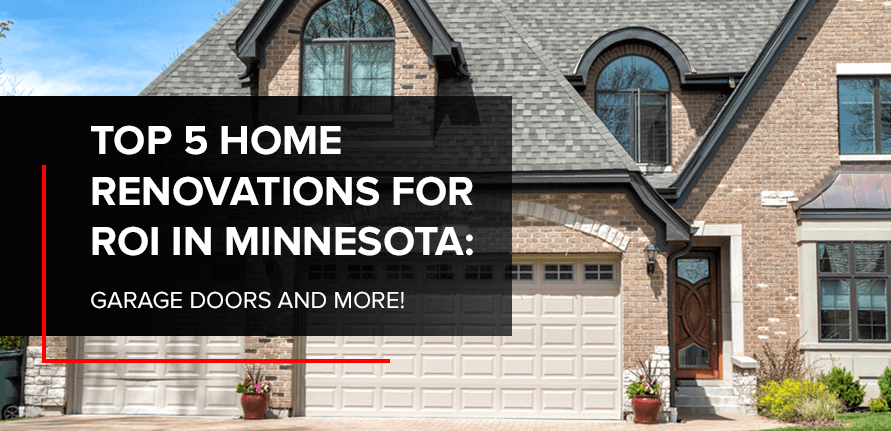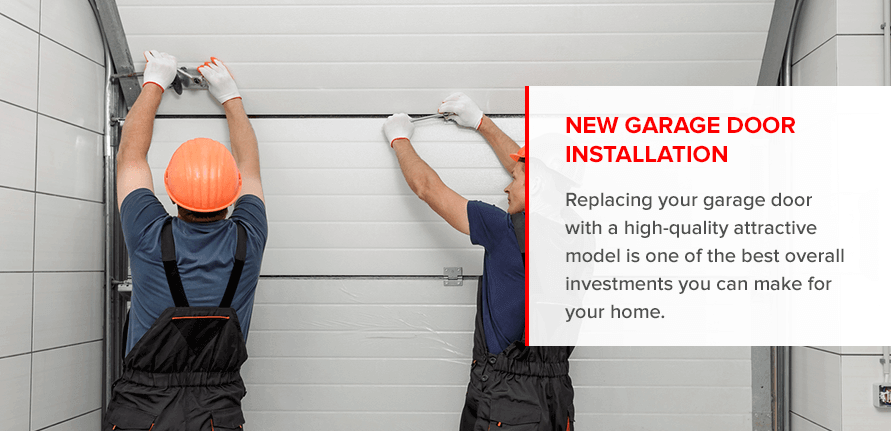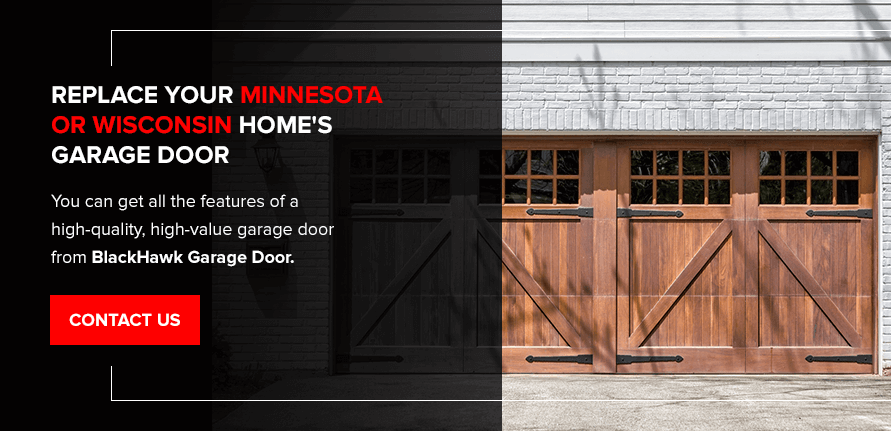How to Prepare Your Garage Door for Winter in the Midwest
As the winter season approaches, you might be getting ready to prep your home for the cold. One thing you need on your to-do list is winterizing your garage door. It could be costly if you overlook this task or put it off until it’s too late.
Your garage door is exposed to rain, sleet, snow and other adverse weather. Without the proper winter garage door maintenance, cold temperatures can cause your door to wear out faster and not operate as it should.
How Can Cold Weather Affect Your Garage Door?
During the winter in Wisconsin and Minnesota, temperatures can drop well below zero. These extreme temperatures can cause the door’s metal parts — especially screws, tracks and springs — to contract. This can make it difficult to open and close your garage door when you need to and make these metal parts more susceptible to warping and breaking.
Without a winterized garage door, you might not be able to close or open it during a snowstorm or deep freeze. If you can’t close your garage door properly, the cold can seep into your home’s living area. Additionally, you may not be able to open your door when you need to leave your home.
How to Winterize Your Garage Door
There are plenty of proactive steps you can take now that will help prevent garage door damage that can occur in cold temperatures. Some of these steps can be done year-round, but they are most effective if you complete them just before winter arrives. It is much easier to take these actions now than it is to get your garage door fixed in the middle of a snowstorm.
1. Check the Door and Tracks
Stand outside and watch your door open and close a few times, listening closely to how it sounds and moves. If you hear the door catch or if it doesn’t move smoothly, it can be an indication that something is not working correctly.
Checking the tracks and the door is something you can do on your own, but you can also ask a professional to inspect your door. Then, if there’s an issue, they can repair it right away.
2. Lubricate the Moving Parts of the Door
This is another step that you can easily do on your own. Lubricate any of the moving parts, like bearings, hinges and springs.
Spray lubricant is a convenient option, but if you don’t have access to any, a few drops of standard engine oil is a good substitute. This will help your door open and close smoothly. Be sure to avoid using grease, though. It can make the tracks sticky and more prone to collecting dust and other debris.
3. Ensure the Weather Stripping Creates a Proper Seal
If you stand in front of your closed garage door and see light coming through the weather stripping, that means your weather stripping doesn’t have a proper seal. It won’t be able to keep the cold air from entering your home — or keep the warm air from escaping to the outside. To ensure maximum comfort during the winter, you might consider replacing your weather stripping.
Even if the weather stripping seems to be in good shape, you still might want to give it a thorough cleaning. Dirt and grime can build up throughout the year and create a poor seal as well. Use a standard household all-purpose cleaner to wipe down the weather stripping.
4. Organize Your Garage
After the warmer weather, your winter items are probably buried and not easily accessible. Ensure items like snow shovels and snow blowers are shifted to the front of the garage so that you can easily access them when the snow sets in. You won’t want to get everything out of the back of your garage when you already have to dig your car and driveway out of the snow.
5. Test the Door’s Balance
If the garage door isn’t balanced, it can make your garage door opener work harder. When this happens, your door may not function correctly or last as long as it normally would — and the effects of being unbalanced can be exacerbated by colder temperatures.
To see if your door is balanced, disconnect it from the opener and manually move it up and down two or three times to ensure nothing is obstructing the track. Then, push the door halfway up. If it stays put with only slight back and forth movement, then it’s most likely balanced. However, if it rolls up or falls down quickly, then it’s not balanced.
You’ll want to get this fixed since unbalanced doors often have a loss of tension in the springs. If the springs break entirely, they can cause even more damage, both to your garage door and potentially even to items you have in your garage.
The best option is to let a professional repair your door since working with torsion springs can be dangerous if you don’t know how to do it correctly. An unbalanced door can also be a sign of an underlying problem that a skilled technician would be able to identify.
6. Inspect and Clean the Surface of the Door
Dirt build-up can damage the surface of your garage door, leading to problems with it opening and closing properly. It can also decrease the lifespan of your door.
Use a brush and soap to scrub the door’s surface. If you see chips or cracks, consider giving it a coat of stain or paint. Fresh stain or paint is also more effective in protecting the door against winter weather.
7. Ensure the Photo Eye Sensors Are Clean and Free of Debris
The photo eye sensors on your garage door are designed to keep the door from closing with something underneath, like a person or a car. If you don’t maintain the sensors, though, they won’t operate effectively. Even dust can keep them from working right.
Keep the senors clean and items away from them so that they can work as best as they can. If you have an older garage door that doesn’t have photo eye sensors, consider upgrading to a new garage door that does. This added safety feature could protect you and your loved ones from potentially being injured or experiencing property damage should your garage door malfunction.
Contact the Professionals at BlackHawk Garage Door
With these tips, you can check certain functions of your garage door to see if they’re working as they should be — but there’s only so much you can do on your own.
BlackHawk Garage Door is a locally owned company providing efficient services and high-quality products. We serve over 10 counties in western Wisconsin and the Twin Cities.
Contact us today, and schedule the service you need to get your garage door ready for this upcoming winter season.
9 Tips to Repurpose Your Old Garage Door
Installing a new garage door will improve the functionality and appearance of your home. When your old garage door comes off, you may wonder what to do with it.
Instead of throwing it away, you can reuse your old garage door to make beautiful decorations and accent pieces for your home. You can transform a worn-out aluminum, fiberglass, solid wood or steel garage door into something new and exciting. This guide will explain nine tips for repurposing garage doors so that you can continue to enjoy them for years to come.
9 Garage Ideas To Repurpose Your Old Garage Door
Once you’ve chosen a new garage door, you can start brainstorming ideas on how to recycle your old garage door. It might be hard to picture them as anything else, but there are many other uses for garage doors. You can make unique home decor or more practical items — the possibilities are endless! Here are some creative ways to reuse your old garage door:
1. Raised Flower Beds
First on this list of tips for reusing your old garage door is to create raised flower beds. Replacing your old garage door can provide the materials to create raised flower beds that add some style to your backyard. This project works with any garage door that has four separate panels.
Once the panels have been separated and cut to your desired size, the assembly process is simple. Arrange the pieces into a square shape and screw them together. You can use a scrap piece of wood or an aluminum angle to connect the corners.
When the raised beds are complete, all you have to do is fill them with soil. Now you can use them to plant beautiful flowers or fresh vegetables and herbs to use in the kitchen.
2. Outdoor Bench
You can transform an old wooden garage door into a charming outdoor bench in a few easy steps. Choose one full panel for the seat portion of your bench. If you would like to add a back to your bench, you can use another panel or prop it against a wall for support.
To create the legs of your bench, you can use another piece of paneling to cut out identical square supports. You can use three or four for extra strength. Now, all you have to do is attach your legs to the bottom of the seat panel. Once it’s finished, you’ll have a rustic outdoor bench where you can relax and unwind.
3. Privacy Screen
This idea might be the easiest project of them all. You can repurpose your old garage door into a privacy screen by standing up your garage door where you want additional privacy. You can use scrap wood or cinderblocks to help hold it in place.
If your old garage door is out of style, you can add a fresh coat of paint and decorate it with large plants and outdoor string lights. With a few simple accessories, it won’t even look like a garage door anymore!
4. Unique Headboard
Vintage garage doors often have interesting paneling and unique designs. If you love the look of your old garage door, you can use it to create a one-of-a-kind headboard for your bedroom.
Choose a section that you want to use as your headboard and cut it to the appropriate size. If it’s a small garage door, you might be able to use three or four panels without making any cuts. You can paint or upholster the panels for a customized design.
Use sturdy brackets to attach your finished headboard to the wall so that it’s safe and secure.
5. Chalk Board
If your garage door panels have a classic grid pattern, you can use them to create a row of chalkboards. Take one panel of your garage door and paint each square with chalkboard paint. You can leave the edges plain or paint them to match your personal style.
Once the paint is dry, you can attach the panel to the wall using a sturdy bracket. Now all you need is some chalk, and you can start writing store lists, weekly schedules and love notes on your brand new chalkboards!
6. Shabby Chic Greenhouse
While it might take some time and additional supplies, you can create your own greenhouse using the window panels of your old garage door. You can keep it simple and make a miniature greenhouse by attaching your window panels vertically. The small rectangular box can hold a few plants for growing herbs and flowers all year round.
If you want a more elaborate greenhouse, you can use the glass window panels from your garage door with other glass materials to make a larger planting shed. If you’ve ever replaced the windows on your home, you can use the old ones for this project as well.
7. Custom Artwork
An old garage door panel is like a blank canvas that you can use to express your creativity. You can paint, tile, stain or carve your old garage door to create a unique piece of art to decorate your home. A wooden panel can add a natural touch to the living room, or a steel door can give your office an industrial aesthetic. You can keep it simple or do something dramatic — it’s up to you!
8. Coat Rack
An old garage door panel is perfect for creating a statement coat rack inside the entryway. You can start by painting or staining the panel to your desired color. If you would like to add a shelf, you can attach a piece of wood to the top half of the panel.
Next, add the hooks. You can choose a hook that matches your personal style and looks decorative when there’s nothing on the rack. Screw the hooks to your garage door panel with several inches in between so there is room to hang large coats and hats.
Now you can mount your new coat rack and start hanging things up!
9. Book Shelf
With a few tools and basic carpentry skills, you can make your own custom shelving for free by repurposing your old garage door. You can use the entire door as the back of a large bookcase or divide the wooden panels to create individual shelves. Once they’re complete, you can use them to display your books or stylish home decor.
Replacing Your Old Garage Door
Before you can start repurposing your old garage door, you need to install a new one. BlackHawk Garage Door offers a wide selection of beautiful garage doors in long-lasting materials, with customizable options such as insulation. Our Clopay and C.H.I. garage doors provide superior function and curb appeal.
BlackHawk Garage Door is a family-owned business that you can trust. Our expert technicians have over 10 years of experience. We pride ourselves on pleasing our customers with honest and professional customer service. We’ll help you enhance your home with a gorgeous new garage door. Contact us today for a free estimate!
Guide to Improving Curb Appeal
Homeowners want to boost their curb appeal for many reasons. One of the most common is the fact that curb appeal is helpful in the real estate market. When a home looks attractive and well-kept from the outside, it brings more buyers in the door for open houses and tours. With more interest, you’re more likely to get an offer, or even several.
Other homeowners are ready to update their home’s look. Maybe it’s been a while since you’ve shown your property some love. Or perhaps you want a home that will impress your guests and rival some of the others in your neighborhood. Your house is something to take pride in, and making a few renovations now and then is one way to give it the care it deserves.
Whether you’re ready to sell soon or are looking forward to enjoying many more years in your home, boosting your curb appeal offers many benefits. So let’s talk about some of the high-impact renovations that will make your home’s exterior look its best.
6 Tips to Boost Garage Door Curb Appeal
Upgrading your home’s exterior has so many possibilities. A few quick updates can improve your home’s appearance on a tight budget, while some more extensive projects can impress your guests and make you appreciate your house every time you come home.
Here’s how to improve curb appeal with a few simple tips.
1. Do Some Landscaping
Landscaping can be a low-cost way to make your home look more put together. Mowing the grass, trimming the hedges and laying a fresh bed of mulch may be all you need to spruce up your front lawn. Even putting in a few lights to illuminate some of your existing plants can give your yard a more sophisticated look. If you’re in the market for a magazine-worthy front lawn, you can hire a professional landscaper. They’ll design an attractive layout, plant some new greenery and decorative features and ensure your property looks perfectly manicured.
Landscaping can increase a home’s value by 5.5 to 12.7%, depending on the type of landscaping involved.
2. Install a New Garage Door
Putting in a new garage door is one of our favorite ways to boost curb appeal. If it faces the street, your garage door takes up a large portion of your façade. And since it’s usually a different color from your primary siding or paint color, it acts as a strong focal point. A new overhead door can make your whole home look brand-new. It can also offer benefits outside of aesthetics, such as increased security.
If you haven’t shopped for garage doors in a while, you’ll soon notice how many styles and colors there are to choose from. Between traditional carriage house doors, classic sectional doors and sleek modern doors like glass garage doors, there’s a style to fit every home. Wood or faux-wood doors can give your home a warm, inviting charm. Steel doors can provide a contemporary or traditional look, depending on the design. To see everything a new garage door can do for your home, visit our Door Imagination System and picture how some of our models will look on your home. You also have the option of adding insulation, which can be extremely beneficial in colder weather.
Another fun way to improve your garage is to add a retractable garage door screen, like the one we offer from Lifestyle. This upgrade is beneficial for homeowners who use their garage as a living space. It turns your garage into a screened-in porch, so you and your family can enjoy some fresh air. You can set up some porch furniture for curb appeal, so your garage looks its best whether you keep the door open or closed.
3. Give Your New Garage Door a Complementary Entry Door
While you’re upgrading your garage, why not get a new front door, too? When you buy the two together, you can select complementary styles and colors that will give your home’s architectural elements a uniform, attractive look. Updating your main entryway is a common suggestion to boost curb appeal because the front door is the home’s natural focal point. At BlackHawk Garage Door, we offer several attractive entry door collections designed to complement some of our most popular Clopay garage doors.
4. Replace Your Mailbox
One of the most straightforward curb appeal tips you can take care of over a weekend is to install a new mailbox. It’s often the first thing visitors see when they pull into your driveway. People coming for the first time usually look for your street address printed on the mailbox. Replacing a dented, rusty or chipped mailbox with a new one helps you make that first impression count. Also, consider dressing up the area around the post with some stones, flowering plants or other decorative features to make it look more welcoming.
5. Repave the Driveway
There’s nothing like fresh blacktop to make a home look new again. Newly paved asphalt has an unparalleled rich blackness that draws the eye toward it. You’ll also remove cracks and smooth out any ridges or dents that have formed over time. If it’s not quite time for a brand-new driveway — most last around 25 years with proper care — you can also consider seal coating or resurfacing.
Seal coating fills in cracks and restores the deep black color of faded pavement. Resurfacing adds a new top layer of asphalt to fill in shallow cracks and dips in the pavement.
6. Spruce up the Front Porch or Stoop
The area framing your front door is also crucial, as it’s highly visible from the street. If you’re in the market to sell your home, think about how many buyers will stand on your front porch as they’re waiting to tour the property. Refreshing your stoop is a crucial focus area when investing in curb appeal. There are also many ways to add charm and beauty to your grand entry. Some tips for improving curb appeal on your front porch include:
- Repaint or re-stain the deck and railing.
- Install new lights and other fixtures.
- Frame your door with two matching potted plants and add touches of green with hanging planters or flower boxes.
- Set up new outdoor furniture or replace the throw pillows.
- Update your house numbers.
- Place down a new welcome mat.
The ROI of Curb Appeal Improvements
Homeowners focused on curb appeal know that exterior renovations can boost their home’s resale value. Besides how to boost curb appeal, many people wonder how much they can recoup on their investments. Which investments offer the highest ROI? We recently reported on some of the highest-ROI renovations in the Minnesota and Wisconsin area, and all of them will make your home look more attractive. Here’s what you can expect from some of the most profitable exterior improvements.
- Garage door: Garage doors top the list with the highest curb appeal ROI. According to the national average, they recoup 94.5% of their value at resale.
- New siding: Replacing your siding is a logical runner-up because it covers the largest portion of your home. New siding can give your home a more vibrant color and remove any cracks or imperfections in the old siding. According to reports for our area, these projects return 68.5% of their value at resale.
- Stone veneer: A manufactured stone veneer offers the natural stone look at a much more affordable price. As such, it can boost curb appeal without requiring a significant upfront investment. At resale, you’ll recoup 67.7% of the cost.
- Entry door: Replacing your entry door is an excellent way to increase a garage door’s replacement value. When you do both at once and choose similar designs, they create a cohesive look, adding to the resale value over replacing the garage door alone.
- Windows: Windows are an excellent investment to attract buyers with curb appeal and entice the energy-conscious buyer, too, by giving your home better insulation. In our area, replacing all your windows will recoup an average of 65.4% of the total project cost.
Contact BlackHawk Garage Door to Boost Your Minnesota and Wisconsin Curb Appeal
Installing a new garage door is one of the best exterior renovation tips on our list because it can improve curb appeal and provide other valuable benefits. For example, installing an insulated garage door increases energy efficiency, saves you money and makes your garage more comfortable. A new garage door will operate smoothly and provide added convenience. Best of all, it makes your home look more inviting with attractive design elements.
Browse our selection of garage doors and contact BlackHawk Garage Door to schedule your renovation project, whether it includes a garage door, a front door or both.
How to Choose a Garage Door for Your Home
Garage doors add significant value to your home. Whether you’re a recent homeowner or you want to revitalize a house you’ve lived in for a while, a new garage door may be the perfect upgrade. With regular maintenance and an updated door, your garage can elevate your home on the real estate market and improve your quality of life.
You want to choose a garage door with function, design and affordability in mind and ensure a result that meets all your home’s needs. Our garage door buying advice will prepare you for every detail — from the top garage door styles to the critical components for an ideal budget. When it’s time to make the switch, feel confident in every step of the process with our additional tips for buying a garage door, taking measurements and hiring professional installation services.
Garage Door Buying Guide
Fall back in love with your home when you replace your garage door and expect a multitude of benefits, including:
- A boost to your curb appeal, security and efficiency.
- Improved comfort and convenience.
- A higher return on investment at resale.
Our buying guide will help you achieve these benefits and more with a new garage door.
Function and Design
When buying new garage doors, remember that function and design go hand in hand. Reach a balance that works for you by choosing the perfect style and finish. Consider how windows can enhance your home’s value with various treatment options to match any design. Incorporate your favorite selections into a practical, fashionable product you’ll love.
Style
Your garage door’s style should reflect your taste and your home’s architecture. When you choose from a wide selection of styles, including our timeless raised-panel, carriage house and contemporary garage doors, you will find a design that simultaneously satisfies the personal and the functional.
Consider starting your search with styles that best fit your home’s structure. For example, full-view style doors are excellent for modern design, while homeowners with Victorian architecture generally prefer carriage-house doors.
Remember, the choice is ultimately yours. You can install garage doors in any style, so embrace the one you love. Feel comforted by the appealing, custom design of your new garage every time you return home.
Finish
Set your property apart with a fun and fashionable finish for your door. Your garage door is a significant portion of your home’s exterior, so captivate yourself and your guests with a color that will keep you interested.
Your choice can be as distinctive or fundamental as you want with our wide range of bold hues and natural wood finishes. We use Clopay’s Color Blast® program to offer you 1,500 Sherwin-Williams® colors, so you’re sure to select a shade worthy of your home. A natural wood finish or a custom tint can provide the ideal appearance to any material or complement any style.
Residential garage doors may experience a range of climates. Choose from different finishes built to withstand various weather conditions. BlackHawk Garage Door professionals can advise you on what finishes hold up best in your area and ensure you receive a functional, cost-effective look you love. The Imagination Design app on their website allows you to visualize what the doors will look like on your home, be sure to check that option out on their homepage.
Windows
Customize your garage door with windows and benefit from their unique capabilities. The natural light from windows will visually open any space and create a welcoming atmosphere. Add windows to any style garage door — you can enhance modern homes or rustic farmhouses with tasteful garage door window placement.
If you live in an area that experiences frequent storms or high winds, consider the practical option of impact-resistant glass. Glass obscurity options provide style and sunlight to your garage while ensuring your privacy and security remain intact.
Affordability
Your budget is essential to create the best custom door for your home. A new garage door’s cost depends on various factors. In addition to the choices you make in style, finish and any window selections, the insulation, material, hardware, size and other needs of your garage door can affect its final price tag. When setting a budget, every homeowner will have distinct priorities rooted in personal, environmental and structural requirements.
Consider what is necessary for a garage door in your area — what will improve your quality of life? Factors that most homeowners consider when choosing a budget include:
- The door’s aesthetic appeal.
- The impact of insulation and the creation of a more energy-efficient home.
- The durability required for the environment and conditions it may face.
- The invariable factors, such as garage door size and the number of doors.
Additional improvements may be more beneficial in the long run, with better durability, energy efficiency and quieter operation. Popular garage door options tend to have an attractive style that boosts home value and can range in price — from under $1,000 to $4,000 and beyond — depending on the size and number of garage doors. Carefully consider how much you’re willing to invest for a fully custom garage door with everything you need.
Insulation
An insulated garage door will significantly impact your home’s energy efficiency and comfort level. When you insulate your door, you limit the transfer of warm or cool air from your garage to the outside — saving you energy and money. Homeowners who use their garage for work or storage should consider how insulation can protect property and maintain an overall comfortable environment. Most garage doors will offer insulation options, so it’s worth thinking about.
Material
Most homeowners will choose a garage door’s material based on style preferences and durability.
Showcase natural wood from various species like hemlock, redwood or cedar. Enjoy a handcrafted, natural style when you choose a Classic™ Wood garage door for your home. Homeowners in need of a durable door will appreciate our range of steel garage doors. An Ultra-Grain wood finish on any steel door option can easily replicate natural wood’s beautiful appearance. This choice is excellent for minimal upkeep and increased durability.
Hardware
Regions prone to high winds can take advantage of Clopay’s WindCode® garage doors rated for different wind speeds. These doors contain built-in hardware for an efficient and secure design. Know your home is safe against high winds when you lock your Storm Ready® door without any need for additional reinforcement.
The tracks can be as crucial to your garage door as the style and finish. They guide your garage door rollers and ensure smooth movements. Improve functionality and convenience with the right tracks for your door. BlackHawk Garage Door can let you know which track options would best suit your garage’s layout and needs, then take measurements to ensure a fully operational door.
Garage Door Size
A typical single-car garage door measures 7′ to 8′ high and 8′ to 9′ wide. Double-car garage doors are generally of a similar height with a width of 16′. Whether your garage door fits these standard measurements or happens to be a non-standard size, BlackHawk Garage Door can accommodate custom sizing and will ensure a perfectly fitted door.
Record your existing garage door’s measurements to install an upgrade with a secure fit.
- Height and width: Measure the height and width of your garage’s framed opening without including stop molding. The garage door’s size will equal this measurement.
- Side room: Measure the available space at the left and right sides of your door. Different spring systems — such as standard torsion spring, standard extension spring or EZ-SET® Torsion Spring — will require a specific amount of side room for the vertical track assembly’s attachment. These measurements ensure a smooth installation.
- Headroom: Measure from the top of the rough opening to your garage ceiling. Remove any obstructions within the space above the door. The garage door, overhead tracks and springs will need a minimum of 10″ for extension springs or at least 12″ for torsion springs to function. If your garage has restricted headroom, contact BlackHawk Garage Door about our available options.
- Backroom: Measure your garage’s length from the rough opening to the garage’s back wall. This measurement should meet or surpass the minimum distance required, which equals the height of the door plus 18″.
Professional Installation for Quality Results
Consider hiring professionals when buying a new garage door. While you might wish to do a DIY garage door installation, remember that this process will require specialized tools and a dedicated length of time. Professional installation provides comfort and convenience, making it a worthwhile investment for many buyers. Hired professionals generally need less turnaround time to complete an installation project than homeowners who choose to try the DIY route.
Promptly return to your daily routine and feel more secure with a quality job done right. When you buy from BlackHawk Garage Door, you can receive a limited warranty with our garage door installation services. Give yourself peace of mind when you switch your old door for a Clopay garage door and receive a one-year installation warranty.
Contact BlackHawk Garage Door in Wisconsin and Minnesota
When you’re ready to switch to a brand-new garage door, trust BlackHawk Garage Door for a quick and thorough buying experience. Customer service is our top priority, and we want to ensure you receive a garage door that’s perfect for your home and your needs. With many residential garage doors to choose from, our expert technicians will help you through every step of the process — guiding you from concept to purchase with additional options for professional installation.
Contact BlackHawk Garage Door today, and see how we can help you achieve a perfect garage door that’s functional, well-designed and affordable.
What’s Wrong With My Garage Door?
Your garage door is likely your home’s largest moving appliance. Like any moving appliance, it can malfunction from time to time. When this happens, it can be a major inconvenience or even a safety hazard. A malfunctioning garage door might leave you stuck, decrease your home’s security or result in damaged property. It might also present a safety concern or cause injury.
If you’re experiencing issues with your garage door, it’s important to determine the cause. Use this guide to help you differentiate between common garage door problems. Once you know what’s going on, you can take steps to resolve the issue and prevent future problems.
My Garage Door Won’t Open or Close
The main garage door issue homeowners face is a door that won’t close or open. Being unable to operate your garage door could cause several issues. Your vehicle could be trapped inside, unusable, or it could be stuck outside, exposed to the elements. A door that’s stuck open will leave all your belongings exposed to the elements, wildlife and theft.
If your garage door won’t close or open, you’ll have to identify the underlying cause. Certain issues are noticeable at a glance, while others may be trickier to diagnose. Some of the most common garage door problems include:
–A broken garage opener: You may think your garage door itself is broken when, in reality, the opener is the issue. If your system’s opener malfunctions, the door may seem to have a mind of its own, refusing to close or opening and closing at random.
–Worn or snapped springs: Garage door springs operate under extreme tension, carrying the weight of the heavy door. If they wear too thin, they can snap, which will leave your door unable to open. Pay attention to the signs of wearing springs, including unusual sounds or movements. As soon as the springs start to wear thin, have them replaced before they snap, as they present a safety hazard.
–Damaged cables: Garage door cables are also important for operation, keeping the door suspended as it glides along its track. If your cables are damaged, you might notice shaky or rapid movement. That movement can be dangerous, so have a professional resolve the issue as soon as possible.
These garage door issues are common and fixable, as long as you can identify the source of the problem and contact a professional to replace or repair parts as needed. By scheduling preventive maintenance, you can reduce the odds of these issues occurring at inconvenient times. Waiting until a noticeable problem arises can end up creating a hassle in the long-run.
My Garage Door Opener Is Broken
Garage door openers provide convenience, allowing you to open or close your door from the comfort of your vehicle. With upgraded technology, you may even have an app paired with your garage, which lets you open it from anywhere in the world. But, like any piece of technology, a garage door opener can malfunction.
If your garage door opener breaks, the door will not be able to open or shut as it should. It might open partially then reverse. It might keep the motor running after the door is in place. Or it might send open or close signals at random. When one of these scenarios happens, a faulty opener may be to blame. Should you experience any of the following situations, you may need to have your garage door opener repaired.
Garage Door Opens Partially
A broken garage door opener might cause your door to open only part-way, then stop or reverse. If your garage door won’t shut, this might also be due to:
–Something blocking the safety sensor or the track
–Broken springs
–A faulty logic control board
Be sure to check for any objects that might be blocking the door’s pathway or sensor. Your garage door has built-in safety sensors that keep it from closing if it detects an obstacle. This feature keeps you and your family safe, but a misaligned or blocked sensor will prevent the door from closing when nothing is in its path. Rake away leaves, shovel away snow and wipe off the sensor. You’ll also want to move any objects near where the door lands.
Once you’ve cleared the area under your door, test whether or not you can open it manually. If it’s an issue with the track or springs, you’ll have difficulty doing so. If the door opens by-hand without issue, then the opener or motor is the problem.
Garage Door Motor Keeps Running
If the garage door motor is running after the door is in place, this may also be the result of a broken opener. It might also be due to a faulty limit switch, which regulates when the motor should start and stop running. You might need a professional to readjust it.
Garage Door Opens and Closes at Random
You might also experience your garage door opening and closing without you operating your remote control. There are a few reasons this might happen, which include:
–Stuck buttons: If a button is stuck on your opener, it might send the signal to open or close the door on its own. Check that your opener button is clean and clear of any debris.
–An identical signal: Your opener remote uses a specific code and signal frequency to communicate with your garage door. There’s a chance your neighbor might have a remote that uses the same signal or frequency, which would cause your door to react when they use their buttons. Be sure to rule out this possibility before investing in a new opener.
–A circuit board short: Another possible explanation for random opening and closing is a circuit board or logic board short. A power surge or other electrical problem can cause this to happen.
My Garage Door Cable Is Broken
Garage door problems can also occur if you need to repair your cables. The cables keep the door lifted as it rolls into place, so strong cables are essential for safety — they can keep the door from falling if the springs snap. The cables work by transferring the stored energy in the springs to the door, allowing it to move along the track. Though they’re the most basic technology of the system, they have to be in good shape for the door to work.
Most garage doors with torsion springs use lift cables, while those with extension springs use retaining cables. Lift cables help pull the door along the track as it lifts, and retaining cables help contain extension springs if they break, keeping them from causing damage.
Broken garage door cables present a safety hazard as well as an inconvenience. Since they work as a failsafe for broken springs, they need to be in sturdy, stable condition. They’re subject to a great deal of friction every time you operate your garage, so they’re bound to wear, snap or pop out of place over time. If you suspect an issue with your garage door’s cables, check for any of these signs:
–Fraying cables: You may need new cables if yours are fraying. Fraying is a normal sign of regular wear and tear, but it does weaken these components.
–Hanging cables: If your cables are hanging out of place, call a professional to realign or replace them.
–Worn or snapped cables: Over time, your garage door’s cables will wear with regular use. If they wear too thin, they might snap.
Have a professional check your garage door cables as part of regular preventive maintenance to promote safety. If you notice any frayed, worn or hanging cables, contact a professional to replace them as soon as possible. You might also encounter either of the following issues.
Garage Door Is Shaky When Opening
You might notice a shakiness as your garage door opens. Faulty cables can cause this unsteady movement. Be sure to address this issue right away, even if your door is still usable at the moment. There may also be a concern with the track itself, which could become bent or misaligned. The door’s wheels might snag along the tracks, causing a shaky opening. A professional can replace the tracks or address other issues causing an unsteady opening.
Garage Door Is Shutting Too Fast
If the cables are broken, the door may not close in a safe, slow manner. Instead, it might fall to the ground, posing a safety risk. Strong, secure cables are necessary for supported, controlled movement. If you notice your door closing faster than it should, contact a professional.
My Garage Door Spring Is Broken
Your garage door’s springs serve a necessary purpose, and it’s important to understand how they work. They operate under extreme pressure, required for lifting such a heavy piece of equipment. Your door uses one of two kinds of springs — extension or torsion. Extension springs, on both sides of the garage, extend to help open the door. Torsion springs twist to help lift the door and sit mounted above it in a tight coil.
The springs provide the force needed to move the door. Depending on your garage door’s weight, it may have a system of multiple springs. A lightweight single-car door may need only one spring, while a heavier, multi-car garage door may need three or four. Some experts recommend torsion springs over extension springs. Since they’re connected to a tube or bar, they’re less likely to come off with force if they break, improving safety.
Please keep in mind, trying to replace one of these springs on your own is hazardous given the extreme tension these springs are under. You might injure yourself or damage your property by trying to fix a broken garage door spring. Always call a professional to repair your garage door springs. If you experience any of the following issues, the springs may be the cause.
Garage Door Is Jammed
As a safety feature, a garage door will jam if the springs are broken. If your door opens a few inches then stops, it might be due to a broken spring. You should not be able to open the door with your remote or by hand in this case. A jammed garage door can also result from other issues — something might be blocking the track, for instance. An object obstructing the rollers will keep the door from opening or closing.
Garage Door Is Squeaking or Popping
Any unusual sounds as your garage door operates are signs of an issue. As soon as you notice any abnormal sounds, you’ll want to schedule maintenance. Screeching sounds, for example, might mean your door’s metal elements need a new coat of lubrication. The sounds associated with garage door malfunction are more than just irritating — they also signal problems. Squeaking or popping sounds are often related to the door’s springs.
If you hear a popping sound, this might indicate a spring breaking. The sudden release of tension from a broken spring can make a loud “pop.” Modern systems have fail-safes in place to keep broken springs from coming off and causing injury or property damage. In any case, these highly pressurized springs can present a serious safety hazard, so you should always call an expert rather than try to repair them on your own.
If you hear a pop that could indicate a broken spring, be sure to contact a professional before using the door again. You may also hear a squeaking or squealing noise, which could mean your springs are wearing thin. Have someone replace them before they snap.
Garage Door Looks Uneven
If you have a multiple-spring system, one spring might snap while the other or others remain intact. If one component is worn or broken, the door might sit higher on the opposite side, appearing uneven. It’s important to fix this as soon as possible since it’s putting extra strain on the side with the working spring.
This strain can lead to rapid wear on that side’s parts, decreasing their working lifespans. Even the smallest garage door is a heavy piece of equipment. It can cause a lot of stress and strain when a broken spring puts an uneven burden on other elements. If you notice this, use the door as little as possible until a professional service can repair the broken spring.
Contact the Professionals at BlackHawk Garage Door
You rely on your garage door every day. Keeping it in top shape saves you from stress and inconvenience and keeps you and your family safe. Even if you keep up with preventive maintenance, unexpected issues can arise on occasion. If you’re having issues with your door or opener, you’ll need a professional garage door repair company to help.
Trust BlackHawk Garage Door with your garage door repair needs. At BlackHawk Garage Door, we provide honest, expert repair services at the hands of our experienced technicians. Learn more about our residential garage door service and repair, and if you have any questions, feel free to contact us today.
Concrete Floor Coating Guide: 10 Uses of Polyurea Flooring
There’s a new name to look for if you’re searching for floor coatings that offer durability, longevity, waterproofing and easy application — polyurea floor coating. In many areas, this coating surpasses the popular epoxy flooring often used in home garages. You will find innumerable uses beyond your garage for applying polyurea flooring.
What’s the Difference Between Epoxy Flooring and Polyurea Floor Coatings?
For starters, both applications can cover concrete, hiding years of wear and tear. But that’s where their similarities come to an end. The two concrete coating options differ significantly in visual appeal, UV stability, durable functionality, moisture barriers, slip resistance and lifespan.
Visual Appeal
Epoxy and polyurea applications can enhance your garage, basement or patio. Epoxy can cover superficial flaws, but it is not a superior way to even out cracked, chipped or dangerously uneven surfaces. The polyurea chip system allows homeowners various options to choose a color that will match the rest of their interior or exterior decor.
UV Stability
Polyurea concrete floor coatings have UV-stable elements that will not fade or yellow with exposure to the sun. Epoxy cannot withstand UV damage and will become discolored over time.
Durability
Salts, chemicals, oils and temperature changes can significantly damage your garage door over time. Polyurea concrete floor coatings are among the most durable flooring choices. Proven to be nearly five times stronger than epoxy, polyurea can withstand heavy traffic, skids, abrasions and impacts. Polyurea concrete floor coatings also offer an impenetrable barrier against moisture and unwanted pests where epoxy does not.
Polyurea is impervious to damage, accidents and mishaps for over a decade, whereas epoxy will protect the flooring from salts and chemicals, but only for a short time.
Unlike polyurea concrete floor coating, epoxy provides less-than-ideal temperature change protection. The material lacks the elasticity to move with your home’s foundation when it expands and contracts. That means it will crack and pop over time in response to temperature changes. Polyurea will expand and contract with your concrete and has proven to be 98% more flexible than epoxy. People who depend on epoxy to withstand Minnesota and Wisconsin winters will encounter pitting, chipping and splitting within a few years.
Moisture Barrier
If your garage floor has a high moisture content, moisture vapor transmission from underneath the slab can delaminate the coating. BlackHawk Garage Door will always bring a moisture reader to your property to determine whether you have a moisture issue. If so, our polyurea floor coating can help.
Slip Resistance
We know epoxy is a non-porous product that creates a smooth surface. However, this can pose a threat when epoxy floors get wet and become slippery, especially with oil spills. With the polyurea chip system, the floor becomes slip-resistant. Ask about the various resistance levels BlackHawk Garage Door offers.
Lifespan
Polyurea is highly elastic (300%) and will accommodate expansion, contraction and relative movement within concrete without cracking. It has a service history that exceeds 25 years. Epoxy is a thermosetting resin that coats the floor, but doesn’t withstand the elasticity you need as your foundation settles. Minnesota and Wisconsin experience harsh winters, and epoxy floors experience pitting, chipping and splitting. Polyurea coatings receive high marks from homeowners and businesses for this reason, in addition to being stain-resistant, UV-stable and antibacterial.
Residential Uses of Polyurea Coatings
Thanks to polyurea’s durability and longevity, you will find many flooring uses that don’t include a surface to park cars on. While most people think of this option as a garage floor coating, there are many more places where you can have us install this flooring.
Garage Floor Coating
Of course, most people think of polyurea coatings for uses of garage flooring. While an epoxy floor may sustain damage from parking your vehicle with hot tires on it, a polyurea-coated garage floor will not. This type of floor can also hold up to the temperature and moisture extremes homeowners experience in our service areas of Wisconsin and Minnesota.
Home Gym Flooring
Because polyurea can stand up to impacts and have the option for varying levels of slip resistance, they are ideal for flooring in home gyms. In such locations, you need a floor that can hold heavy weights or machines, plus resist cracking or chipping if you drop a weight on the floor. Whether you have multiple workout machines or a single treadmill and set of free weights, polyurea flooring will offer the lasting performance you need.
Laundry Room Floor Coating
Laundry rooms require a durable surface that can stand up to moisture, humidity and temperature changes. For instance, when you run a clothes dryer, the room will heat and the humidity will rise. You also need a surface that offers slip resistance in case water from wet clothes gets on the floor. Polyurea flooring is the solution to these needs.
Workshop Floor Coating
In a workshop, polyurea will suffice for most applications. The only possible concern you might have is when you weld materials over the coating. While polyurea coating can stand up to heat, it may burn from welding’s excessive temperatures. Otherwise, as a workshop floor coating, polyurea will help reduce dust that might accumulate on a bare concrete floor and offer a slip-resistant surface, improving the area’s safety.
Finished Basement Flooring
For finished basements, you want flooring that is durable and easy to clean. Polyurea requires only spot cleaning to remove spills. However, with its stain resistance, you don’t need to worry about a spilled drink in your basement rec room causing a permanent problem. Dust mops suffice for removing any dust from the surface, and you can use a sponge mop for regular cleaning of heavily trafficked areas.
Outdoor Pool Areas
Epoxy floor coatings won’t stand up to the moisture, UV rays and temperature swings that an outdoor pool area would experience. Therefore, you need a durable surface coating like polyurea. Plus, you can choose various slip resistance levels for your surface. Around a pool, you want the maximum possible slip resistance to make the area safe for everyone.
Commercial Applications for Polyurea Flooring
Homes are not the only places where polyurea flooring has uses. Businesses in all industries made this floor coating their surface of choice long before consumers discovered its benefits. From auto shops to hospitals, many businesses can take advantage of this surface’s durability and long life with a faster application time than epoxy.
Auto Shop Flooring
Auto shops require tough flooring that can resist damage from hot tires, dropped tools and stains. Polyurea floor coatings excel in these requirements where epoxy floors would not. Additionally, with one-day installation, your business won’t need to delay operations long when you have polyurea installed.
Warehouses
Warehouses have heavy vehicular and foot traffic, plus weight from the shelves and stored products. Workers cannot risk slipping and falling in such a busy location. You need polyurea’s slip resistance that can also hold up for years.
Car Dealership Showrooms
Car dealership showrooms have unique needs. First, the flooring needs to hold up to customers walking over it daily. Additionally, the floor cannot experience stains or wear from vehicles driven over it as you pull model cars into their display locations. Lastly, the floor must look good and hold up for a long time. Polyurea flooring has many color and chip options to customize your space’s appearance.
Hospitals
The floors in hospitals undergo heavy traffic, but they must also be easy to sanitize. Polyurea flooring is antibacterial, preventing viral spread and allowing for quick sanitation. It also protects people walking on the surface from slipping. In a hospital setting, durability and ease of cleaning are essential attributes of any floor coating.
Contact BlackHawk Garage Door for Polyurea Flooring
With our one-day installation in most commercial and residential locations, you can begin to enjoy your new flooring much sooner than if you had epoxy installed. Find out more about our polyurea flooring on our site, or contact us at BlackHawk Garage Door for questions or to request an appointment. Our professional technicians are ready to help you get better flooring for your garage, gym, workshop or any other space where you need polyurea floor coating’s extra benefits.
Insulated vs. Uninsulated Garage Doors
Whether you’re getting rid of your old garage door or picking one out for your new home, you have lots of decisions to make as you begin shopping for a new garage door. With so many styles and materials to choose from, you have plenty of options to fall in love with. Another crucial choice is whether to invest in an insulated garage door.
What’s the Difference Between Insulated vs Non Insulated Garage Doors?
Most garage doors offer insulation options, and making the right selection will affect your daily comfort and energy costs. Let’s weigh the pros and cons of insulating your garage door to see if it’s worth it for you.
- Advantages of Insulated Garage Doors
- Disadvantages of Insulated Garage Doors
- Advantages of Uninsulated Garage Doors
- Disadvantages of Insulated Garage Doors
Are Insulated Garage Doors Worth It?
The difference between insulated and uninsulated garage doors is a thick layer of foam. The foam allows the garage to retain heat in the winter and keep cooled air inside during the summer.
When homeowners compare insulated garage doors vs. non-insulated doors, the insulation almost always wins them over. They have a host of fantastic benefits!
What are the Benefits of Insulated Garage Doors?
1. They Increase Your Home’s Value
Upgrading your garage door is one of the smartest home improvements you can make. It offers an impressive return on investment, especially in Wisconsin and Minnesota. When you choose an insulated garage door, you increase your home’s value through curb appeal and energy efficiency. Insulated garage doors look sturdier and more attractive, which helps attract buyers when it’s time to sell. Since the house is more energy-efficient, buyers are willing to pay more upfront.
2. They Save Energy
Insulated garage doors seal up one of the largest gaps in your home’s thermal envelope. By keeping the heat in during the winter and out during the summer, they lessen the burden on your HVAC system. You’ll use less electricity to keep your home comfortable, saving you money. Insulating your garage door is one of the best ways to make your garage more energy-efficient.
3. They Keep Your Garage Warmer in Colder Months
An insulated garage door makes your garage considerably warmer. Some homeowners find their insulated garage doors increase their garage’s temperature by an average of 49 degrees over the outdoor temperature, depending on the r-value of the garage door.
If you use your garage as a workshop or living space, you’ll be warmer and more comfortable. If you use your garage to park your vehicle, an insulated garage door is more convenient. You’ll walk into a warmer vehicle and come home to a cozier garage. It makes transporting groceries or buckling kids’ seat belts that much easier.
4. They’re Quieter
One unexpected benefit of insulation is its sound absorbency. A thick layer of insulation can shield you from nearby barking dogs and traffic. If you use power tools or listen to loud music in your garage, you won’t disturb your neighbors. Bouncing a basketball off a garage door sounds about three times quieter on an Intellicore® insulated garage door than it does on an uninsulated door.
The insulation also works to dampen the door’s sound. Insulation fills in the gaps between the door’s steel layers, which absorbs noise. It will open and close more quietly to avoid waking sleeping babies or pets and give your entire household some peace.
5. They’re More Durable
Insulation adds a thick, inner layer to your garage door, giving it more impact resistance. The foam can absorb the shock from daily openings and impacts, making the door less likely to dent.
Besides the added durability, insulation also protects the garage door opener. In a warmer garage, the motor and metal moving parts will stay in better condition and last longer, which means lower costs on garage door opener repair.
6. They Protect Your Vehicle and Belongings
An insulated garage door protects your vehicle from extreme temperatures. Cold weather limits your battery’s capacity and could leave you with a dead battery. It also thickens fluids like antifreeze and motor oil, which could cause malfunctions. Cold air can also reduce your tire pressure. Any of these issues could shorten your vehicle’s life or send you to a mechanic.
Beside your vehicle, you more than likely store lots of temperature-sensitive materials in your garage. Things like motor oil, paint, fertilizers and cleaning chemicals can change consistency in extreme temperatures.
Damage to your vehicle and other belongings is less of a concern in a warmer garage due to having an insulated garage door versus a non-insulated door.
7. They Offer Flexible Insulation Options
When you pick an insulated garage door, you can select the garage insulation R-value that will meet your needs and budget. What is R-value? Essentially, it’s a measure of a material’s resistance to heat flow. A high R-value creates better insulation, keeping heat indoors and the cold outdoors. In the summer, it works the other way around, keeping your air conditioning inside. Garage door insulation comes in many R-values allowing you to select moderate or excellent insulation.
Disadvantages of Insulated Garage Doors
While insulated garage doors provide many benefits, they’re not for everyone. Some people don’t choose insulated doors because of downsides like these below:
1. Insulated Garage Doors Cost More Than Uninsulated Models
The main downside to insulated garage doors is their cost. Even the most economically priced insulated garage door will cost more than a similar uninsulated model. It’s crucial to weigh the upfront investment against long-term energy savings. You could save money down the line, both through a lower energy bill and a slight boost to your home’s resale value.
2. They Don’t Benefit You If the Garage Is Open
An open insulated garage door is no different from an uninsulated one. Upgrading to an automatic opener with myQ connectivity is a fantastic way to eliminate this drawback. The myQ app turns your automatic opener into a smart device. You’ll receive alerts when you’ve left your door open and can shut the door from your phone, no matter where you are.
The Pros and Cons of Uninsulated Garage Doors
Uninsulated garage doors come in the same attractive styles as their insulated counterparts. The only difference is what you can’t see. Instead of a layer of foam insulation behind the steel, it’s hollow space. In comparing insulated vs. uninsulated garage doors, you’ll find some pros and cons to the uninsulated models.
Advantages of Uninsulated Garage Doors
Uninsulated garage doors are a smart investment for some homeowners. While they’re not for everyone, an uninsulated garage door has some plus sides.
1. They’re Less Expensive
An uninsulated garage door’s primary advantage is the lower price. When comparing insulated vs. uninsulated garage door costs, the uninsulated version of your chosen door will always cost less. For the lower price, you get fewer layers of steel and no protection from the cold. However, you’ll also pay more for electricity.
2. They’re Practical in Mild Climates
A high R-value garage door isn’t necessary for everyone. In mild climates, homeowners don’t need to turn up the heat or air conditioning quite as often. An uninsulated garage door does the job.
In Minnesota and Wisconsin, it’s a different story. In Minnesota, the average low temperature ranges from 8 to 13 degrees Fahrenheit in the coldest months. In Wisconsin, the lows often dip to 1 degree Fahrenheit in January. In these bitter winters, an insulated garage door will pay for itself in saved heating costs.
3. They Work Well for Detached Garages
The top advantages of an insulated garage door are energy efficiency and comfort. If you have a detached garage, these two benefits become less important. With a detached garage, your heating system isn’t in the same building, and the insulation will not affect your home’s energy efficiency. Your insulated garage also won’t be much warmer without a heater inside. If you use a detached garage as living or working space, or use it for storage, it might still be worth it to get an insulated garage door. It will make any space heater or heat pump more efficient.
Disadvantages of Uninsulated Garage Doors
Uninsulated garage doors have some major drawbacks to consider.
1. They’re Not Energy-Efficient
The main drawback of an uninsulated door is that it provides no heat resistance. As a result, it lets your heating and air conditioning escape outdoors. Energy waste is a significant concern for people with attached garages. If your garage is next to climate-controlled rooms in your house, the heat loss through your garage will make your HVAC system work harder.
2. They Make Your Garage Less Comfortable
Without heat flow resistance, your garage will feel much like it is outdoors, no matter the season. If you spend time in the garage, you might prefer the added comfort of insulation.
3. They May Limit Your Storage Options
With more temperature fluctuation, many of the items you store in your garage are at risk. Wood may expand and contract more dramatically, causing cracks. Moisture-sensitive items will be susceptible to more humidity, and liquids may thicken. If you use your garage for storage, an uninsulated garage won’t provide the protection you need.
4. They’re Less Durable
An uninsulated garage door is hollow. A single-layer door won’t even have an inside face. This feature means the door is more likely to dent. Continually hitting your garage floor may cause extra wear, especially if it doesn’t have a protective floor coating. Tapping the door with your car or a soccer ball might also leave a dent.
5. They’re Noisier
Without insulation, a steel garage door has an empty cavity inside. As the door opens, vibrations rattle and echo inside that empty chamber. While some people are content with tuning it out, others can’t ignore it. The noise might wake people up late at night or early in the morning.
Is Insulating Your Garage Door Worth it?
If you’re looking for a garage door that’s quiet, energy efficient, durable and works better in cold climates, an insulated garage door is going to be the best investment to fulfill your garage door needs. If you live in a milder climate, an uninsulated garage door could get the job done.
Contact BlackHawk Garage Door for New Garage Doors
At BlackHawk Garage Door, we have an excellent selection of garage doors that will fit any home and budget. Whether you choose insulated or uninsulated doors, we’ll help you find a style you’ll love. BlackHawk Garage Door is a family-owned business providing dependable service in the Twin Cities and throughout Western Wisconsin. For more information on the doors and insulation options we offer, contact our garage door experts online or give us a call today for your free estimate.
8 Tips for Making Your Garage Door More Secure
The front door, back door and windows of your home are the top three spots a potential burglar could use to break in. Another opening you shouldn’t forget is your garage door. Nine percent of thieves attempt to break in through the garage. No matter the statistics, you’ll likely want to ask yourself, “How can I make my garage door more secure?”
Your garage stores plenty of valuable items, from tools and sports equipment to your vehicle. It also allows access to your home, making garage door security vital. We’ve put together this guide to show you how to secure your garage door and make your house and everyone inside safer.
1. Ensure the Door Closes
This is among the simpler garage door security tips. Many homeowners drive out of their garage and down the driveway, closing the garage door behind them — but they may not always watch to ensure it closes all the way. If you leave to run errands and don’t notice the garage door stayed open, you’re inviting burglars into your garage and your home. Wait a few extra seconds before driving away to save yourself the potential for a future disaster.
If you find that your garage door isn’t shutting, you may have an issue with the opener or the sensor. Check that there aren’t any items blocking the path of the sensor and preventing your door from closing. Have a professional inspect your garage door system if you can’t see any obvious issues.
2. Change Your Opener Code
So how secure is a garage door? That all depends on how secure you make it. Many homeowners have a PIN that lets them access their garage, and it’s essential to keep that information private. Only share this code with members of your household. If you ever have to share your PIN with someone else in an emergency or if they’re housesitting, change it when they’re done. You can also create a new code if you notice suspicious activity around your neighborhood. Pick a unique number that you don’t use for any other PINs.
It’s essential to change your garage opener PIN when you get a new system, as well. Many garage openers come with a preset code that’s factory-standard, meaning a burglar could easily attempt to guess your PIN.
3. Use the Manual Lock
If you’re going away on vacation or don’t plan on using your garage for some time, use the manual lock to prevent a garage door break-in. Secure your garage door from the inside with a manual lock, often located at the center of the door. You can also engage the manual lock if you experience a power outage. That will prevent anyone from forcing it open from the outside. Just remember to unlock it before you try to use your garage door opener again.
4. Keep Your Opener Remote Inside
Many homeowners have garage door openers in their cars, but it’s not necessarily wise to keep them there. If you park your car outside, you risk allowing a burglar to break into your car, take the remote and open your garage. That leaves your home vulnerable until you replace the entire opener system and regain garage door security. Bring your opener remote inside when you get home or use an opener key fob to help keep your garage secure.
5. Maintain Your Door
Burglars can capitalize on broken locks, faulty windows and other poorly maintained entryways. To know how to make a garage door more secure, you also have to know how to maintain it. Routine maintenance keeps your garage safe for your family to use, and it can help prevent break-ins. Broken garage door panels, weak hinges and rusted bolts leave your garage door at risk for damage, which a thief could easily take advantage of.
For the best routine garage door maintenance, trust the professionals. Get annual service for your garage door or reach out to us if your garage door looks damaged or uneven, opens slowly or is loud when it opens. Those are all signs that your garage door needs a bit of upkeep, and we can diagnose and correct any issues your door may have.
6. Get a New Garage Door Opener
If you have an older garage door lift mechanism, you risk having a damaged or outdated system. Older technologies mean that a burglar could copy the opener remote frequency onto another device. That gives them access to your garage as if they’re using the same opener you do.
For a secure garage door opener, choose newer models with advanced technology that create a rolling code. This means a burglar can’t duplicate the opener’s frequency onto another remote and access your garage. Consider a new garage door opener that will protect your home and give your door a smoother operation.
7. Secure the Emergency Release Cord
The emergency release cord for your garage door is a handy feature for you, but don’t let it be an access point for burglars. Some thieves use a method called “fishing” to push a wire hook through a gap at the top of your garage door. They’ll use the wire to grab the release cord and pull it, which could open the door. While fishing is challenging and pulling the cord towards the door won’t always open it, it’s still a risk.
Secure your garage door release cord using a shield designed to cover the cord. That’s a much safer method of garage door security than cutting the cord or zip-tying it. You don’t want a thief to access the release cord, but you may still need to use it at some point.
8. Trust BlackHawk Garage Door to Secure Your Garage Door
Now that you know how to secure garage doors, take steps to make your property safer with BlackHawk Garage Door. Our family-owned business provides dependable service in the Twin Cities and throughout Western Wisconsin. Whether you need garage door repairs, residential products or commercial products, our expert technicians are ready to help. With competitive pricing and many technicians with over 10 years of experience, you know we’ll provide thorough and quality maintenance and installation to meet your garage door needs.
Regain peace of mind when you secure your garage door with BlackHawk Garage Door. Contact us today for free and honest estimates.
How to Make Your Garage Door Energy Efficient
[lwptoc depth=”1″ numeration=”none” colorScheme=”inherit”]
Garages are very beneficial for homeowners. They offer a safe storage place and add extra square footage — but your garage can also be wasting money and electricity. One of the largest culprits for garage-related energy waste is an old, damaged or poorly insulated garage door.
Energy-efficient garage doors are an excellent asset because they provide:
- A more comfortable space: If your garage doubles as a workshop, gym, studio or apartment, then a comfortable temperature is essential. Energy-efficient garage doors prevent costly and uncomfortable temperature fluctuations.
- An eco-friendly alternative: About 40% of the United State’s energy consumption goes toward producing electricity. Much of this energy produces greenhouse gases and other pollution. The less power you consume, the more environmentally-friendly your home will be.
- Lower energy costs: Fluctuating garage temperatures are costly to keep up with, especially if your garage is attached. If the temperature is unstable in your garage, it can lower or raise the temperature inside your house.
- Increased resale value: Insulated garage doors, automatic door openers and garage insulation are great ways to boost your home’s resale value because they promise lower utility costs. They also save a potential buyer from having to make upgrades themselves.
Read on to learn more about how to make your garage door efficient.
Insulate the Door
The best way to insulate a garage is to start with the door. An insulated door can help maintain a more comfortable and controlled temperature inside your garage, keeping it up to 12 degrees warmer in the winter and 20 degrees cooler during the summer heat. Garage door insulation can also block out unwanted noise transfer, which is ideal for those who have garage workshops. You can measure an insulated garage door by its R-value. R-value refers to the level of effectiveness for each layer of insulation based on factors like its density, age and type.
When it comes to insulating your garage, you have two choices — use a do-it-yourself insulation kit or consult a professional garage door technician to help. DIY kits come with foam board insulation, reflective insulation or batt insulation to hang along the inside of your door. While this may be an inexpensive solution, a professional garage door technician will get the job done right and take one thing off your to-do list!
Seal Garage Door Cracks
If there are cracks between your garage door and the walls or floor, hot and cold air can easily flow in and out throughout the day. If you rely on an air conditioner or heater to regulate your garage’s temperature, this outside airflow will cause a spike in your energy consumption — and your bill. To seal garage door cracks, apply weatherstripping in areas with large gaps. Weatherstripping is a firm, sometimes flexible strip that fits around your door to prevent lost energy and temperature fluctuation. As you open and close your garage door, weatherstripping on the bottom will not break or scratch because it is made of durable rubber, vinyl or silicone, though some may be made of aluminum or a similar metal.
If your garage door already has weatherstripping, check that it is still attached correctly and in good condition. Signs that indicate possible weatherstripping damage include:
- Excessive drafts around your door.
- Visibly worn or damaged stripping with tears, cracks, dents or corrosion.
- Water puddles, insects or other evidence that the stripping is no longer doing its job.
Contact your garage door servicer for further guidance about how to seal garage door cracks.
Upgrade Your Garage Door Opener
If you have an automatic garage door opener, make sure it’s sized correctly for the job, and there are no visual or audible signs of strain. The harder a garage door opener has to work to move your door, the more energy it consumes in the process. You could also consider upgrading from a standard automatic garage door opener to one with built-in smart technology.
Smart garage door openers tend to use less electricity than a standard automatic door opener because you can program them to turn on and off at specific intervals throughout the day, rather than standing idle. With automatic closing, you also eliminate the possibility of accidentally leaving your door open when you leave your home for the day — an accident that is both a security risk and a significant energy waster.
Replace Your Door With a More Energy-Efficient Garage Door
A damaged or worn garage door is one of the quickest ways to rack up a hefty energy bill. Replace your garage door to reduce garage energy consumption if you have any holes, cracks, rust or excessive dents and scratches. When choosing a new, more efficient garage door, consider the following:
- Material: Each garage door material has different advantages. For example, steel is strong and resistant to most damage. When constructed out of several layers or combined with insulation materials, it’s also great for temperature regulation. Wood, composite wood and doors made of blended materials are also suitable for insulation.
- R-value: Always check the listed R-value for a garage door before making your investment. The higher the R-value, the better it will be for insulation.
- Windows: Garage door windows can be very beneficial, especially if you want to save money by using more natural light. That said, garage door windows can also be a source of energy loss for many homeowners. To combat this, make sure your windows are installed correctly, and there are no gaps or cracks around the windows. You can also consider adding an insulated or low-emissivity glaze to the glass to prevent excess heat transfer.
Schedule Preventative Garage Door Maintenance
Regular garage door maintenace is the best way to address minor concerns before they turn into larger, more energy-wasting issues later. With preventative maintenance from BlackHawk Garage Door, a specialist will visit your home at least once per year to inspect your door’s performance and appearance. They will check each part of your garage door, including the track, nuts, bolts, hardware and springs. The technician will also apply complete lubrication to all moving parts and address any additional concerns you might have.
Additional Tips for an Energy-Efficient Garage
Once you have made your garage door more energy-efficient, you can take some additional steps to create a more energy-efficient garage, including:
- Unplug all unused appliances, such as tools, machinery and exercise equipment.
- Switch to energy-saving lightbulbs and appliances.
- Turn off the light during the day or use natural light when possible.
- Regularly inspect all wiring for energy-wasting damage.
Contact BlackHawk Garage Door for Maintenance and Installation
An energy-efficient garage door is an important investment for your home or business. At BlackHawk Garage Door, we take pride in offering fair and honest service with competitive prices. Visit us online to learn more about our residential and commercial garage door solutions or contact us today to request a free estimate.
Top 5 Home Renovations for ROI in Minnesota: Garage Doors and More!
With all the benefits you can get out of a home improvement investment, you also want to ensure you’re getting the most value for your money. You want to take on remodeling projects that have a high ROI and add value to your home. What are home-buyers most willing to pay for in Minnesota or Wisconsin? We broke things down by the numbers, so you can get the best value for your home renovations.
What to Consider When Choosing a Home Renovation
Home renovations can range from completely redesigning your home, a single room or replacing some outdated elements. When you’re concerned about the resale value for a home project, the most important thing to consider is the upfront cost. Any home renovation should begin with a budget that reflects the project’s extent. When ROI comes into play, the ideal renovation has a relatively low upfront cost and will be seen as high value to potential buyers.
The more you invest upfront, the harder it will be to match that investment during a sale.
It’s also smart to consider renovations that add value beyond ROI. If you’re planning to live in the same home for a few more years before reselling, you should choose renovations that contribute to your happiness and make your life easier. If you spend a lot of time enjoying your yard, exterior renovations can boost your quality of life. A deck or porch renovation, for example, can make your outdoor experiences that much more enjoyable.
You also want to consider what added functionality a home renovation can bring to your residence. For example, a kitchen renovation might allow you more cabinet and countertop space. If you have an old garage door that doesn’t move smoothly and seems to get stuck often, a garage door replacement can make pulling into your garage a little easier and less of a hassle. You’ll recognize the benefit every time you head out or come home when you choose the right home improvement, such as these:
1. New Garage Door Installation
Replacing your garage door with a high-quality attractive model is one of the best overall investments you can make for your home. Why? First, exterior renovations tend to have a higher ROI because they increase curb appeal. A visually appealing outer appearance gets more buyers in the door and raises a home’s perceived value. A garage door makes up a good portion of that outer layer and ties the exterior together to create a focal point.
Investing in a new garage door also comes at a fraction of other exterior renovation projects, such as roof replacement, landscaping or deck additions.
Besides its high resale value, a garage door can provide other savings in the form of energy efficiency. Replacing a non-insulated garage door with an insulated one can help your home retain heat in the colder months and keep hot air out in the summer. As a result, your home’s heating and cooling system doesn’t have to use as much energy for climate control, and you can take advantage of excellent savings. We offer a variety of insulation options to meet your desired energy efficiency goals and budget.
A garage door is also a long-lasting investment. If you install one with quality construction and continue to maintain it, it will last 15-30 years. While you’ll need to replace the spring every 10,000 cycles — or openings and closings — and other hardware as required, the door itself will last a long time and continue appealing to buyers years after your investment.
2. Siding Replacement
Like garage doors, new siding can increase your curb appeal and attract buyers. As a result, it’s the second-highest ROI renovation in our location. Since siding covers a lot more area, you should expect to invest more upfront. The more expensive fiber-cement has a higher ROI. The average siding renovation will cost $19,964 upfront and recoup $13,667 at resale in Minneapolis. The average ROI for a fiber-cement siding job is 68.5%, making it one of the best home renovations.
Siding can give your home’s façade a refreshed look. If your current siding has taken a beating from harsh weather, this can be an important upgrade for those looking to sell their home. It also presents the opportunity to select a new color for your house.
3. Manufactured Stone Veneer Installation
As an alternative to siding, stone gives your home a natural look. You’ll find some surprisingly authentic options available with manufactured stone veneer. Manufactured stone comes with a lower price tag than real stone, and generally places less stress on your structural frame. Since it looks attractive to buyers without as high of an investment, artificial stone is an excellent choice.
You can apply a stone veneer in many places in your home, from a fireplace mantle to a shower backsplash. For the highest ROI possible, install it on your residence’s street-facing exterior, where it can increase curb appeal. When you replace about one-third of your home’s front-facing siding with a manufactured stone veneer, the project will cost about $10,777, on average, in Minneapolis. You’ll earn back an average of $7,300 at resale for a 67.7% return.
It comes in many styles, such as warm, earthy tones or cool slate grays. You can find veneers that replicate rectangular stone blocks or create a more organic pattern with a rougher texture.
4. Entry Door Replacement
While smaller than a garage door, an entry door has just as much of an ability to be your home’s main focal point. Since the front door is one of the first parts of your home a buyer interacts with, it can leave a lasting impression. Replacing an old, shabby door with a sturdy, eye-catching steel one can improve your curb appeal and resale value.
For an added boost to your ROI, consider replacing your entry and garage doors together with complementary designs. At BlackHawk Garage Door, we offer several collections of entry doors to complement our most popular overhead garage door designs.
5. Window Replacement
As one last improvement to your exterior, windows can be a worthwhile investment for ROI. Besides improving curb appeal, modern windows will likely enhance your home’s energy efficiency. Between extra panes of glass and weather-tight seals, better windows will let in less moisture and keep your home warmer all winter long. Those energy savings can increase your ROI beyond what you’ll earn at resale. Plus, savvy buyers will recognize the advantage of efficiency.
The average vinyl window installation, assuming you have 10 windows, will run you around $19,139. You’ll earn back $12,524 at resale for a 65.4% ROI, a slight bump to the ROI for wood window replacement.
Replace Your Minnesota or Wisconsin Home’s Garage Door
After crunching the numbers, you probably noticed that the garage door replacement ROI is far ahead of even the second-best home improvement in our area, and it comes at a fraction of the upfront cost. The key to getting the most from your garage door’s ROI is choosing an attractive, durable door that will draw in buyers and let them know they won’t need to replace it for years to come. You can add some additional value for yourself through improved energy efficiency.
You can get all the features of a high-quality, high-value garage door from BlackHawk Garage Door. Browse our overhead door collections and try our Door Imagination System to find the one that will look best on your home for higher curb appeal. Contact us today!

